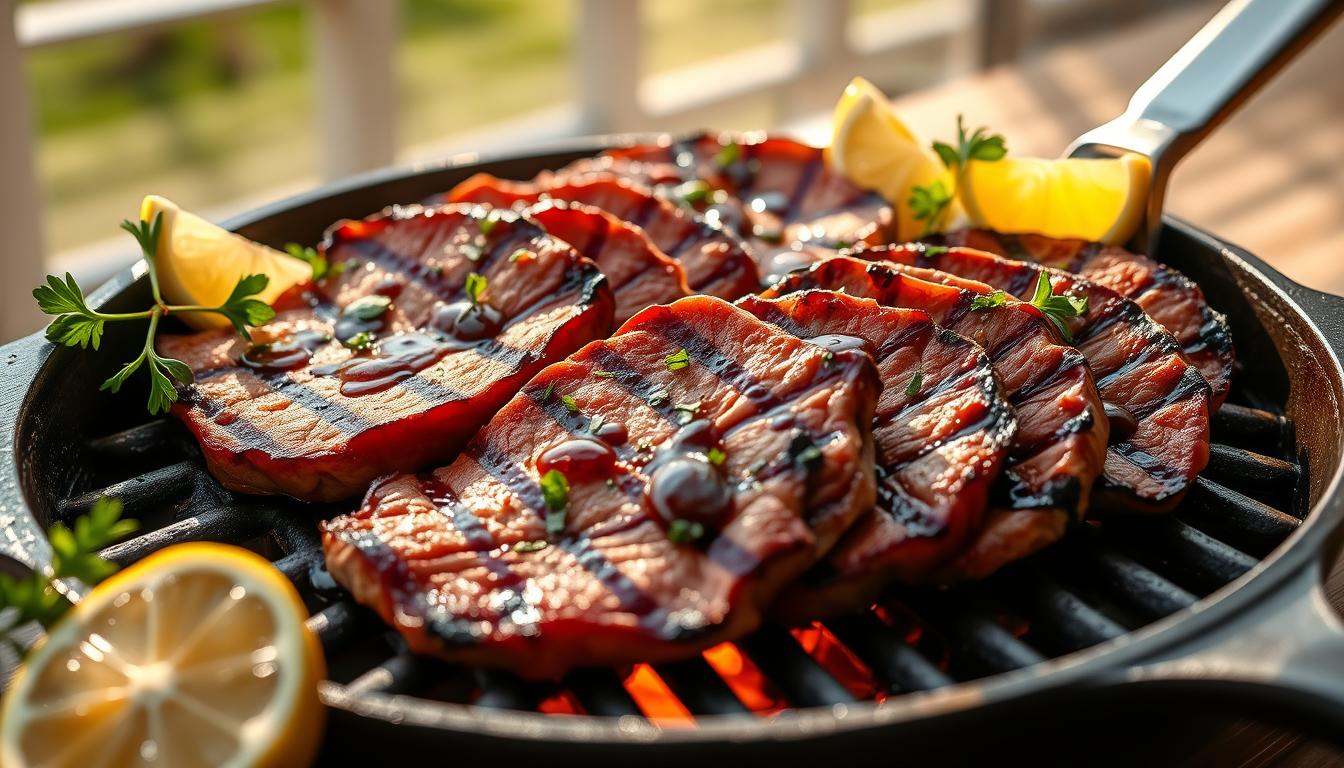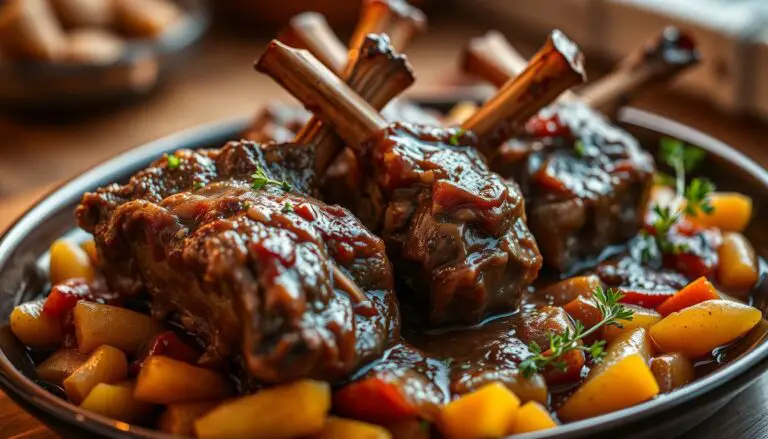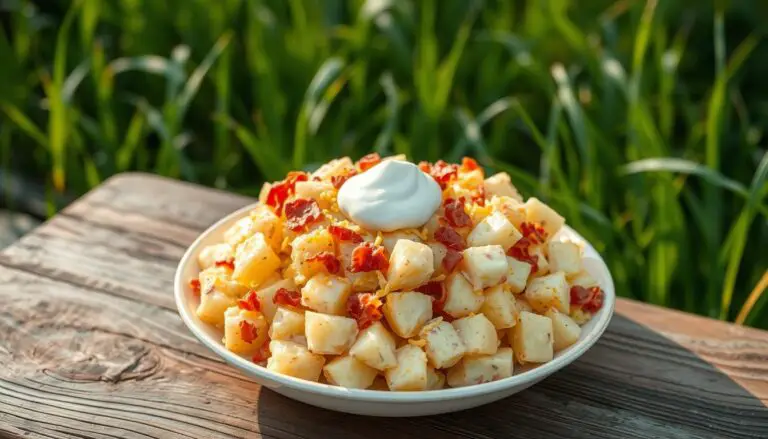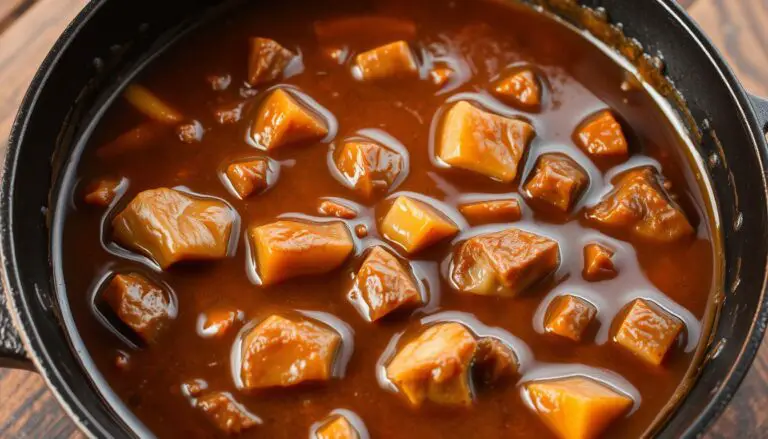As a home cook, I’m always on the lookout for quick and delicious meal solutions. One of my favorite options is cooking with thin steaks. Whether it’s for a weeknight dinner or a special occasion, thin steaks offer a versatile and flavorful choice.
Thin steaks, generally considered any steak less than 1″ thick, can be cooked in a variety of ways and are perfect for dishes like fajitas, stir-fries, or schnitzel. The beauty of thin steaks lies in their ability to absorb flavors quickly and cook in a short amount of time.
In this article, I’ll be sharing 7 quick and tasty thin steak recipes that you can try at home. From classic beef dishes to international inspirations, these recipes showcase the versatility of thin steaks and provide you with new ideas for your next meal.
Key Takeaways
- Quick cooking times make thin steaks ideal for busy weeknights.
- Thin steaks can be used in a variety of cuisines, from Mexican to Asian-inspired dishes.
- The 7 recipes covered in this article offer a range of flavors and cooking methods.
- Thin steaks are perfect for absorbing flavors and marinades.
- Cooking with thin steaks is a great way to add variety to your meal routine.
What Are Thin Steaks?
Thin steaks, often considered any cut less than 1″ thick, offer a range of culinary possibilities. The term “thin” can refer to steaks that are naturally cut to be thinner or those that are sliced thinly for specific recipes like fajitas or stir-fries.
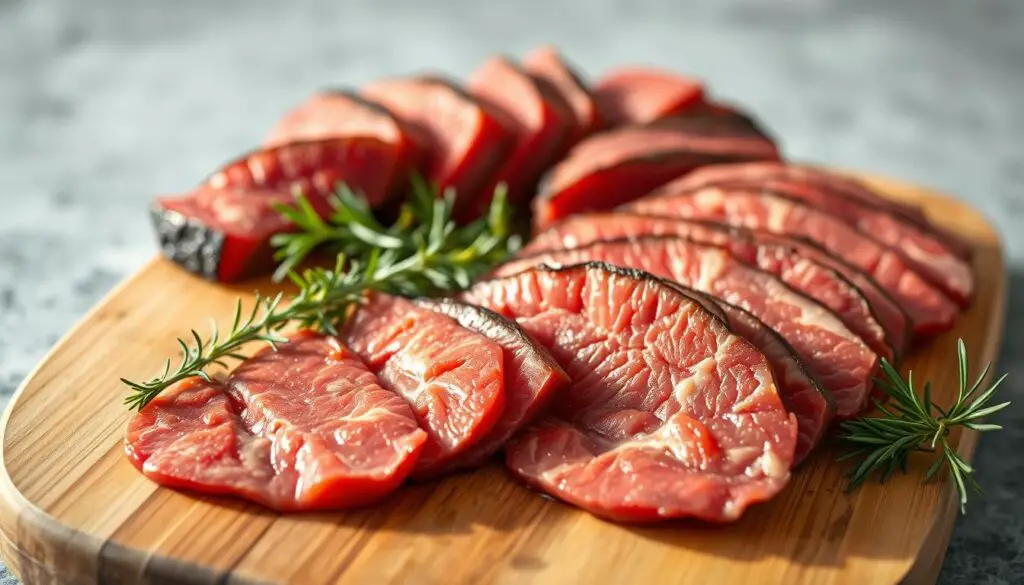
There are several characteristics that define thin steaks. They can be naturally thin cuts or thicker cuts sliced thinly. This distinction is important because it affects not only the cooking method but also the overall dining experience.
Thin steaks differ significantly from their thicker counterparts in terms of cooking requirements. They cook much faster and are more prone to overcooking if not monitored. However, they can be just as flavorful, especially when marinated or seasoned properly.
- Thin steaks are generally more affordable than premium thick cuts, making them a budget-friendly option.
- They can be found pre-cut at most grocery stores or butcher shops, adding to their convenience.
- The versatility of thin steaks allows for a wide range of recipes, from classic beef dishes to international cuisine.
In summary, thin steaks are a versatile and affordable option for many beef recipes. Whether you’re cooking for one or preparing a meal for a group, understanding the characteristics of thin steaks can elevate your culinary skills.
Types of Thin Steaks You Can Use
Thin steaks are not limited to a single cut; they can be obtained from various parts of the beef. This versatility allows for a wide range of options when it comes to choosing the perfect thin steak for your meal.
The diversity in thin steak cuts means that you can select the most appropriate type based on your recipe, cooking method, and personal preference. Two popular types of thin steaks are Flank and Skirt Steak, and Shaved and Minute Steaks.
Flank and Skirt Steak
Flank steak and skirt steak are both lean cuts that are known for their robust flavor and firm texture. They are ideal for dishes where the steak is sliced thinly against the grain, making them tender and easier to chew. These steaks are often used in stir-fries and fajitas.
Shaved and Minute Steaks
Shaved steaks are cut extremely thin, making them perfect for quick cooking methods. They can be derived from various cuts, but are often taken from tougher primals like the round. Minute steaks, similarly, are named for their quick cooking time. These ultra-thin cuts are ideal for sandwiches, stir-fries, and other dishes where fast cooking is essential.
To obtain shaved or minute steaks, you may need to request them from a butcher if they’re not available pre-packaged. These cuts are unified by their thin slicing, which allows for rapid cooking and tender results.

Understanding the different types of thin steaks available can elevate your cooking, providing you with the flexibility to prepare a variety of dishes. Whether you’re using flank steak, skirt steak, or opting for shaved or minute steaks, the key to a great meal lies in the quality of the cut and the technique used in its preparation.
Why Thin Steaks Are Perfect for Quick Meals
Thin steaks offer a culinary solution for those seeking fast yet flavorful meals. One of the main advantages of thin steaks is their incredibly fast cooking time, making them ideal for busy weeknights.
When you blast your pan or wok on high heat, you can achieve a dark crust on the steak quickly without overcooking the meat. This method is particularly effective for thin steaks, allowing for a deliciously cooked beef steak in under 10 minutes.
- Thin steaks can be prepared rapidly, making them perfect for weeknight meals.
- They absorb marinades more quickly than thicker cuts, enhancing the flavor.
- Thin steaks are more forgiving for beginner cooks due to their quick cooking time.
- They can be incorporated into a variety of dishes from different cuisines, offering versatility in recipe development.
- Whether you’re making a simple recipe or something more complex, thin steaks are a great choice.
Incorporating thin steaks into your meal routine can significantly reduce cooking time without compromising on flavor, making them an excellent addition to any meal recipe.
Essential Cooking Techniques for Thin Steaks
Cooking thin steaks to perfection involves more than just throwing them on the grill or pan; it requires a grasp of specific cooking techniques. Two crucial aspects of cooking thin steaks are high heat methods and proper slicing techniques, both of which significantly impact the final dish’s tenderness and flavor.
High Heat Methods
High heat methods are ideal for cooking thin steaks as they allow for a quick sear on the outside while keeping the inside juicy. This technique is crucial for achieving a tender and flavorful piece of meat. Whether you’re grilling or pan-searing, ensuring your cooking surface is hot before adding the steak is key to getting a good sear.
Proper Slicing Techniques
After waiting 5-10 minutes for the meat to rest, make sure you cut across the grain. This means cutting perpendicular to the muscle fibers that run parallel across the steaks. Snapping those strands is what makes the meat a lot more tender! When serving sliced beef, cutting it thinly sliced against the grain is essential for maximizing tenderness.
To achieve the ideal slice, identify the direction of the muscle fibers, or the grain, and slice accordingly. This technique not only enhances the tenderness but also improves the overall dining experience. For various dishes, slicing the cooked thin steaks to the right thickness is crucial. Keeping the meat juicy when slicing and serving is also vital, and this can be achieved by not overcooking it and slicing it just before serving.
- Cutting against the grain ensures the steak is tender and easier to chew.
- Identifying the grain in different cuts of steak is crucial for proper slicing.
- Proper slicing techniques directly affect the tenderness of the final dish.
- The ideal thickness for slicing cooked thin steaks varies depending on the dish being prepared.
- Slicing just before serving and not overcooking the steak helps keep the meat juicy.
The Perfect Thin Steak Marinade
A good marinade is the secret to making thin steak dishes truly unforgettable. All good restaurants that make fajitas and stir-fries marinate their steak in advance, and it’s a technique you can easily replicate at home.
Marinades help tenderize the meat before cooking, and the oil helps distribute seasoning across the meat while providing a uniform cooking surface. To create a great marinade, you need a few essential ingredients: salt, a bit of oil (matched to your cuisine), pepper, something acidic (like balsamic, Worcestershire, vinegar, lime juice, or lemon juice), a mix of your favorite spices (such as cumin, chili, or paprika), and a bit of sugar if you prefer.
My go-to marinade recipe works for most thin steak dishes. It involves mixing minced garlic, a bit of soy sauce, some olive oil, salt, and a selection of spices that suit your taste. For example, you can add some chili flakes for a spicy kick or some paprika for a smoky flavor.
The science behind marinades is fascinating. The acidic components help break down the proteins in the meat, making it more tender. Meanwhile, the sauce or marinade adds flavor to the steak, ensuring it’s juicy and delicious.
When it comes to marinating time, thin steaks typically require less time than thicker cuts. A few hours or even overnight can make a significant difference. However, be cautious not to over-marinate, as this can make the meat mushy.
Different cuisine styles call for different marinade variations. For an Asian-inspired dish, you might use soy sauce and ginger. For a Mexican dish, you could use lime juice and cumin. The possibilities are endless, and experimenting with different flavors can help you find your new favorite recipe.
To maximize flavor absorption while maintaining the meat’s texture, it’s essential to balance the marinade ingredients and not overdo it. A good rule of thumb is to adjust the marinating time based on the thickness of your steak and the acidity of your marinade.
In conclusion, a well-crafted marinade can elevate your thin steak dishes from good to great. By understanding the basics of marinades and experimenting with different ingredients and styles, you can create delicious meals that will impress anyone.
7 Delicious Thin Steak Recipes
I’ve selected seven incredible thin steak recipes that highlight the diversity and flavor of this beloved cut of beef. These dishes are perfect for various occasions, from quick weeknight dinners to more elaborate entertaining.
The beauty of thin steak lies in its versatility. Whether you’re in the mood for something spicy, savory, or rich, there’s a recipe to suit your taste. Here are seven mouth-watering options to consider:
- Global Inspirations: From Mongolian Beef to Classic Beef Fajitas, these recipes draw inspiration from cuisines around the world.
- Cooking Techniques: You’ll find a range of cooking methods, including grilling, pan-searing, and stir-frying, each bringing out unique flavors in the steak.
- Adaptability: These recipes are adaptable based on your dietary preferences and the ingredients you have on hand.
Some of the standoutthin steak recipesinclude:
- Garlic Butter Sizzle Steaks, perfect for a quick and flavorful dinner.
- Beef Stir Fry with Vegetables, a colorful and nutritious option.
- Philly Cheesesteak Sandwiches, a classic comfort food dish.
These recipes not only showcase the steak as the main ingredient but also highlight the accompanying flavors and sides that make each dish special. Whether you’re cooking for one or a crowd, you’ll find that beef is a crowd-pleaser.
By incorporating different marinades, seasonings, and cooking techniques, you can elevate your steak dishes and keep your meals exciting. I encourage you to explore these seven thin steak recipes and enjoy the culinary journey they offer.
1. Garlic Butter Sizzle Steaks
In just a few minutes, you can have garlic butter sizzle steaks on your plate, served with your favorite sides. This ultra-quick recipe combines the rich flavors of garlic and butter with thin steaks, making it perfect for a weeknight meal.
The cooking technique behind the signature “sizzle” effect involves quickly searing the steaks in a hot skillet. To achieve this, ensure your skillet is hot before adding the steaks, and don’t overcrowd it. This method allows for a delicious crust to form on the steak.
Preparing this recipe takes under 10 minutes, making it ideal for busy evenings. Simply season the steaks with salt and your choice of herbs, then sear them in a skillet with melted butter and minced garlic. Serve with steamed frozen vegetables for a well-rounded meal.
For complementary side dishes, consider steamed broccoli, roasted asparagus, or a simple green salad. These options pair well with the flavorful steaks without overpowering them.
To achieve the perfect garlic butter sauce consistency, avoid overcooking the butter. Instead, melt it in the skillet, add minced garlic, and cook for just a minute until fragrant. Then, add the steaks and cook to your desired level of doneness.
2. Mongolian Beef
Thin steak is the perfect cut for Mongolian beef, a popular Chinese-American dish that’s both savory and sweet. This dish is characterized by its rich, savory brown sauce that coats the tender beef, making it a flavorful meal that’s quick to prepare.
The signature sauce of Mongolian beef includes key ingredients like soy sauce, hoisin sauce, and chili peppers, which give it a spicy kick. To balance the savory and spicy flavors, a touch of brown sugar is added, allowing the sauce to caramelize beautifully.
One of the reasons thin slices of beef work so well in this dish is their ability to absorb the rich flavors of the sauce. By slicing the beef thinly, it cooks quickly and evenly, ensuring that each piece is coated in the savory sauce.
Achieving the right balance of sweetness and umami in the sauce is crucial. To get it just right, you can adjust the amount of brown sugar and soy sauce to your taste. This flexibility makes it easy to customize the dish to your preferences.
To achieve restaurant-quality Mongolian beef at home with minimal effort, focus on using high-quality ingredients and following a few simple cooking techniques. With practice, you’ll be able to enjoy this delicious dish whenever you want.
3. Beef Stir Fry with Vegetables
One of the tastiest ways to enjoy thin steak is in a Beef Stir Fry with Vegetables. This versatile dish combines the tender flavor of beef with the crunch of fresh vegetables, all wrapped up in a savory sauce.
To start, toss thinly sliced steak with cornstarch and let it sit for 10 minutes. This technique, known as velveting, ensures the beef remains tender. Meanwhile, mix soy sauce, ginger, garlic, salt, pepper, and brown sugar in a bowl to create the marinade. Coat the steak with half of this marinade and sear it in olive oil for 2-3 minutes per side until browned. Set the steak aside.
In the same pan, stir-fry asparagus and green onions for 2-3 minutes. You can also add bell peppers or your favorite vegetables to the mix, making the dish highly customizable. Once the vegetables are cooked to your liking, add the cooked steak back to the pan and pour in the reserved marinade. Stir everything together and cook for 1-2 minutes until the sauce thickens slightly.
The key to a great stir fry is maintaining the crisp-tender texture of the vegetables. Avoid overcooking them to keep the dish vibrant and healthy. Additionally, the sauce should coat both the meat and vegetables evenly, so adjust the consistency as needed.
This Beef Stir Fry with Vegetables recipe is not only delicious but also quick to make, perfect for a weeknight dinner. Feel free to experiment with different vegetables based on the season, making this recipe a staple in your culinary repertoire.
4. Classic Beef Fajitas
When it comes to quick and flavorful meals, few dishes beat the simplicity and taste of Classic Beef Fajitas. This Tex-Mex favorite showcases thinly sliced beef strips cooked with colorful bell peppers and onions, all wrapped in warm tortillas.
The key to authentic fajitas lies in the marinade, which typically includes a mix of lime juice, garlic, and spices that give the beef its distinctive flavor. For a more detailed breakdown, I recommend Jessica Gavin’s comprehensive recipe, which provides an in-depth look at creating the perfect fajita marinade.
Cooking techniques are crucial for achieving that perfect char on both the thinly sliced beef and the vegetables. A hot skillet is essential, and cooking the ingredients quickly over high heat ensures they retain their texture and flavor.
Serving suggestions include warm flour or corn tortillas, along with traditional toppings such as sour cream, salsa, and avocado. To create that signature sizzle when serving, make sure to heat your skillet or griddle before adding the cooked beef and vegetables.
By following these steps and using the right ingredients, you can enjoy beef fajitas with a delicious pepper and onion mix that’s sure to become a staple in your meal rotation.
5. Beef with Broccoli
One of the most popular Chinese-American dishes is beef with broccoli, and it’s surprisingly easy to recreate in your own kitchen. This classic dish is a staple in many Chinese restaurants, and with a few simple ingredients, you can make it at home.
The key to a great beef with broccoli dish lies in its savory sauce. The sauce is typically made with a combination of soy sauce, oyster sauce (optional), and other seasonings. To achieve the right consistency, you can use cornstarch as a thickener.
To make this dish, you’ll need fresh broccoli and thinly sliced beef. I recommend using grass-finished flank steak for the best results. The beef should be stir-fried quickly over high heat to preserve its tenderness.
When cooking the broccoli, the goal is to achieve tender-crisp florets that complement the beef nicely. This can be done by briefly blanching the broccoli in boiling water or steaming it until tender.
By making beef with broccoli at home, you can control the ingredients and make it healthier than restaurant versions without sacrificing flavor. The result is a delicious and satisfying meal that’s sure to become a favorite.
6. Philly Cheesesteak Sandwiches
For a truly authentic Philly experience, you can’t go wrong with a cheesesteak made from shaved steak. This iconic sandwich is a staple of Philadelphia cuisine, and its simplicity is part of its charm. The key to a great Philly Cheesesteak is using high-quality ingredients, including thinly sliced beef, fresh vegetables, and the right type of cheese.
When it comes to the cheese, there’s an ongoing debate between provolone and Cheese Whiz. Provolone offers a more traditional Italian flavor, while Cheese Whiz provides a creamy, processed taste. The choice ultimately comes down to personal preference. If you’re looking for an authentic experience, you might want to try both and see which one you prefer.
Cooking the shaved steak and vegetables is a crucial step. You’ll want to achieve the right texture by cooking the steak quickly over high heat. Sautéed peppers add a sweet and crunchy contrast to the tender beef. Make sure to slice the steak against the grain to ensure it’s as tender as possible.
The bread is another important component of a Philly Cheesesteak. A crusty roll is essential, as it holds up to the juices and cheese without getting soggy. You can toast the roll lightly to enhance its texture and flavor.
Assembling the sandwich requires some finesse. You’ll want to balance the amount of beef, cheese, and vegetables to ensure each bite is flavorful. To keep the sandwich from getting soggy, consider toasting the roll and adding the cheese just before serving.
In conclusion, a Philly Cheesesteak Sandwich made with thinly sliced beef and melted cheese is a delicious and satisfying meal. With the right ingredients and cooking techniques, you can create an authentic Philly experience at home.
7. Beef Schnitzel
Beef schnitzel, a classic German recipe, is a fantastic way to enjoy thin steaks with a crunchy exterior and tender interior. This dish transforms thinly sliced beef into a mouth-watering meal that’s both quick to prepare and delicious.
To make beef schnitzel, start by pounding the beef steaks to ensure even cooking and tenderness. You don’t need a meat mallet; a rolling pin or any flat tool will do. Next, prepare a breading station with flour, eggs, and breadcrumbs. Season the flour with salt and pepper to add flavor.
The breading process is crucial for achieving the signature crunchy exterior. Dip each steak in the flour, then the eggs, and finally the breadcrumbs, pressing gently to adhere. Fry the breaded steaks in hot oil until golden brown, then drain on paper towels.
Serve the beef schnitzel hot with traditional accompaniments like lemon wedges. The brightness of the lemon makes a big difference, cutting through the richness of the dish. For a perfect recipe, don’t skip this detail.
With these simple steps, you can enjoy a delicious beef schnitzel recipe that’s sure to impress. Thinly sliced beef, when cooked correctly, results in a tender and flavorful dish.
Pro Tips for Cooking Thin Steak Recipes
To elevate your thin steak recipes, it’s essential to master a few key techniques that can make all the difference in the final dish. Cooking thin steak is an art that requires precision and attention to detail.
Getting the Perfect Sear
Achieving a perfect sear on your steak is crucial for locking in flavors. To do this, ensure your pan is hot before adding the meat. A good sear requires a combination of high heat and the right cooking oil. I recommend using a skillet or cast-iron pan for this purpose.
Resting Your Meat
Resting your steak after cooking is just as important as cooking it correctly. Steaks continue to cook even after they’re removed from the heat, and letting them rest allows the juices to redistribute, making the meat more tender and flavorful. For thin cuts, a resting time of 5-10 minutes is usually sufficient.
To keep your steaks warm during this time, you can tent them with aluminum foil. This technique not only retains heat but also helps in maintaining the quality of the sliced beef. Adding a sprinkle of pepper just before serving can enhance the flavor profile.
- Resting allows the protein strands to relax and reabsorb juices.
- The appropriate resting time can vary based on the thickness of the steak.
- Techniques like tenting with aluminum foil help keep the meat warm.
- Timing your meal correctly ensures that everything is ready when the steak has properly rested.
Conclusion
As we wrap up our culinary journey through the world of thin steak recipes, it’s clear that these versatile cuts of beef offer endless possibilities for quick and delicious meals. The key to mastering steak cooking lies in understanding the right techniques and being open to experimenting with various recipes.
Throughout this article, we’ve explored the different types of thin steaks and the essential cooking methods that bring out their best flavors. From the simplicity of a garlic butter sizzle to the complexity of a beef stir-fry, each recipe showcases the versatility of thin steak. By incorporating these ideas into your meal planning, you can significantly simplify your cooking process without sacrificing flavor.
I encourage you to try out the different thin steak recipes presented here and explore new ways to enjoy beef. Mastering the art of cooking thin steaks not only expands your culinary repertoire but also opens up a world of quick, tasty meal options that are perfect for any day of the week.

